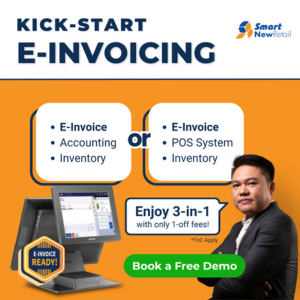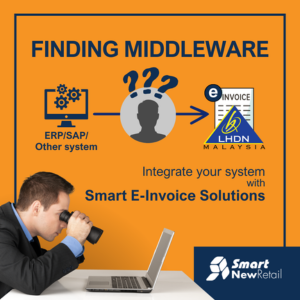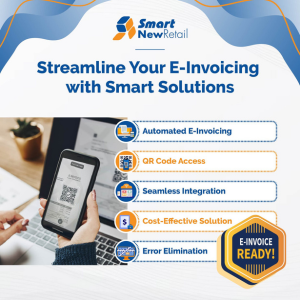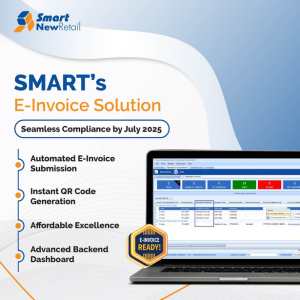E‑Invoice Malaysia Made Easy – Compliant E‑Invoice POS System for Every Business
Businesses across Malaysia are increasingly adopting digital tools to streamline their daily operations. With the new Malaysian e-invoicing regulations coming into effect, switching to an e-invoicing system is not just beneficial, it's mandatory. Manually handling paperwork, tracking errors, and complying with tax rules can become cumbersome and inefficient. An e-invoice POS system solves these challenges, ensuring everything is organised and allowing you to focus on what matters most: running your business.
At Smart-Acc, we have crafted a simple and effective e-invoice pos system for businesses of all sizes. Whether you are a single shop owner or managing multiple outlets, our solution helps you maintain compliance while simplifying the management of your sales and taxes.
What Is an E‑Invoice System in Malaysia?

Malaysia’s e-invoicing system is transforming how businesses manage their invoicing. Instead of printing documents and storing boxes of receipts, companies now send invoices online. This system transmits them directly to LHDN, the national tax authority, which promptly verifies and stamps them for approval.
Once LHDN completes its verification, the system tags the invoice with a QR code and a unique reference number. You can then store it securely and access it at any time. By using e-invoice Malaysia’s software, you reduce errors, accelerate your workflow, and ensure ongoing compliance. This transforms your invoicing into a smooth, one-click process.
How Does E-Invoice System Work?
The e-invoice system in Malaysia
operates by transforming paper-based invoicing into a streamlined, digital
experience. Here’s how it works:
Create
The supplier generates an invoice using the POS system or other billing software, which integrates with the e-invoice system.
Send
The
system transmits the invoice to the IRBM through the MyInvois portal or an API
link to the government’s database.
Verify
The government’s system checks and confirms the invoice in real time, ensuring it meets all regulatory guidelines.
Notify
Once validated, both the seller and the buyer receive a confirmation, complete with a Unique Identification Number (UIN) and QR code.
Distribute
The seller sends the validated invoice to the buyer, ensuring accuracy and transparency in the transaction.
Many POS systems are cloud-based. This means businesses can access data from anywhere. Cloud-based systems offer real-time updates and backup options.
This real-time process eliminates the guesswork, making sure every invoice you send complies with the regulations in e-invoice system Malaysia.
Malaysia E‑Invoicing Timeline & Compliance Requirements
Malaysia introduces a clear plan for businesses based on how much they earn each year:
1 January 2026
1 July 2026
Below RM500,000
If your revenue lands in the first two ranges, you must use the e-invoice system by the dates listed. Sending invoices by hand or just over email won't count anymore. First, register with LHDN, then install approved electronic invoicing software that handles your invoices correctly. Waiting too long could bring fines and record-keeping problems.
Key Features of an Effective E‑Invoice POS System
LHDN/MyInvois Integration
The Malaysia e-invoicing system links with LHDN's My Invoice platform. When you issue an invoice, it zips to the government system. My Invoice checks and sends it back with an official QR code and ID, no waiting.
POS & Accounting Sync
You can pair your checkout counter with your accounting system. The POS updates instantly, and your reports, taxes, and invoices stay aligned. You won't need to copy numbers or switch between apps.
Automated Tax Calculations & QR Codes
Malaysia's e-invoicing system crunches tax amounts for you. It adds them to each invoice and generates QR codes on the spot. You avoid math errors and send correct documents every time.
Cloud Access & Mobile Use
Use the e-invoice system wherever you go. Log in from a phone, tablet, or laptop, whether in the shop or away. It works online, so you always stay connected and updated.
Invoice Correction & Cancellation Tools
If something goes wrong, you can fix it quickly. Cancel or edit invoices right from the dashboard. You don't waste time or break any rules—everything adjusts smoothly.
Scalable for B2B/B2C
The system scales with you, whether you serve customers or supply other businesses. Handle one invoice or a thousand without changing how the system works.

Top Benefits of Smart-Acc's E‑Invoice Software

Saves Time on Daily Tasks
Smart-Acc removes steps from your daily routine. It tracks, sends, and stores invoices in one place. You won't chase paper, redo mistakes, or search for numbers at the end of the week.
Avoids Penalties with Built-In Compliance
The system follows Malaysia's tax rules with no guessing. It shapes each invoice in the correct format, fills in the right codes, and sends everything to LHDN for checking.
Boosts Accuracy and Reduces Mistakes
Smart-Acc catches errors before you send them. It fills out totals, tracks invoice numbers, and double-checks your inputs. This keeps your records clean and correct.
Access Anytime, Anywhere
You control the system from anywhere. Your team can check invoices from home, the office, or travelling. Everyone sees the same updates in real time.
Works Well with Retail Tools
The e-invoice POS system blends with your sales and inventory tools. When someone buys something, the system tracks the sale, updates stock, and sends an invoice—all at once.
Simplifies Audits and Reports
When it's time for an audit, you stay ready. Malaysia's e-invoicing system stores every invoice with a time stamp and tracking code. You can pull reports in seconds, so no paper folders are needed.
How to Choose the Right E-Invoice System in Malaysia
Finding the right e-invoice system in Malaysia for your business can seem overwhelming, but focusing on a few key aspects can help you make the best choice:
● Scalability: Pick a system that grows with your business and can handle increased transaction volumes.
● Compatibility: Make sure the system connects smoothly with your current POS and ERP software.
● Ease of Use: Choose an intuitive platform that minimizes the learning curve for your team and reduces user errors.
● Compliance: Ensure the system meets all LHDN regulations to keep your business aligned with government standards.
● Support: Select a provider that offers excellent customer support and troubleshooting to help you through technical challenges.
Considering these factors helps you find an e-invoice system that meets your specific business needs and supports long-term growth.

Why Smart‑Acc Stands Above the Competition
Smart-Acc connects your sales, accounting, and compliance in one powerful place. With over 20 years of experience, we design systems that work according to business needs. Our e-invoice software feels easy to use but comes packed with tools that save you hours every week. Businesses trust Smart-Acc to keep things simple, fast, and ready for e-invoice Malaysia.
How to Get Started
Getting started takes only a few steps. First, register with LHDN on the My Invoice portal. Then, contact Smart-Acc to book a demo. We walk you through the setup, link it to your sales tools, and help train your team. You'll send test invoices, get comfortable with the platform, and stay ahead of your compliance date. Our team supports you every step of the way.
FAQs
-
What's the difference between an e-invoice system and e-invoice software?
An e-invoice system covers the whole process, from making to sending and checking invoices. E-invoice software is the tool you use to run that system. It handles each invoice and talks to the tax department.
- Is Malaysia's e-invoicing mandatory for all businesses?
- Can this work on mobile?